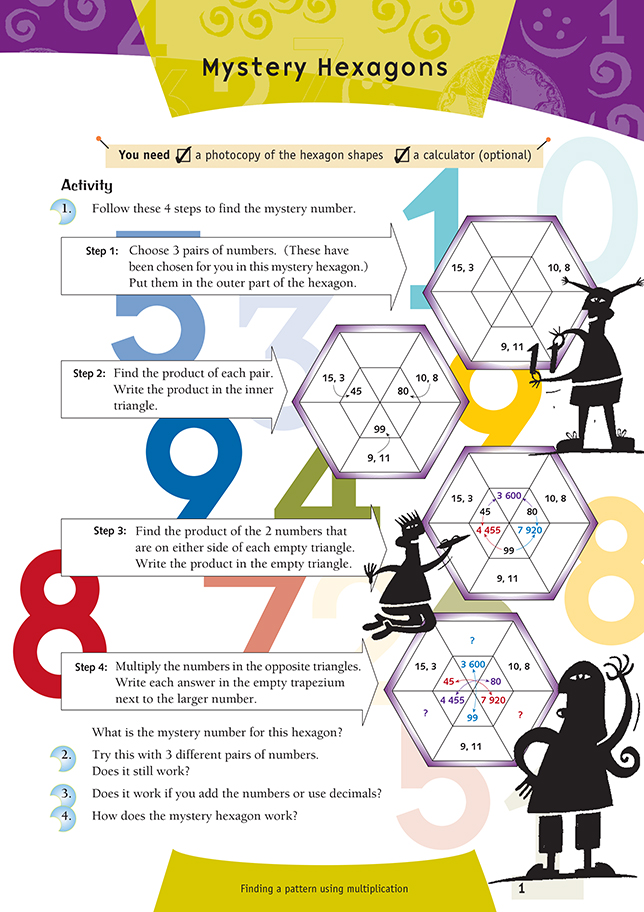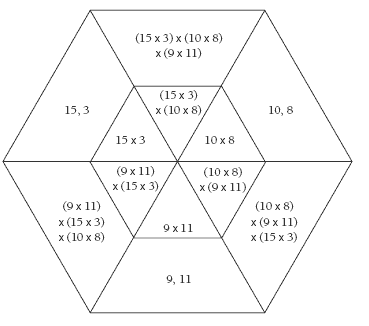This is a level 4 number and algebra activity from the Figure It Out series. It relates to Stage 7 of the Number Framework.
A PDF of the student activity is included.
Click on the image to enlarge it. Click again to close. Download PDF (198 KB)
find a pattern using mutliplication
explore the commutative property
Hexagon Shapes Copymaster
FIO, Level 3-4, Number, Book 2, Mystery Hexagons, page 1
A calculator
This activity develops students’ skills and confidence in communicating mathematical ideas. For this activity, the students need to be able to derive multiplication answers, so it is appropriate for those who are at or beyond the advanced additive stage of the Number Framework. You can support the growth of your students’ mathematical vocabulary by modelling, explaining, and encouraging the use of mathematical terms that convey specific meanings. Some of the key number words you could reinforce during this activity are: “factor”, “product”, “addends”, “sum”, “decimal”,
and “commutative property”. (See the Answers for an explanation of the commutative property.)
You could introduce this activity to the students by modelling it on the whiteboard. If you don’t want the students to use calculators, try limiting the initial factors to whole numbers between 1 and 10. This will make the mental calculations easier, and the students could use strategies such as doubling and halving (8 x 5 = 4 x 10), tidy numbers (9 x 8 = 10 x 8 – 8), tens facts (5 x 5 = 25 so 5 x 50 is 10 times greater; 5 x 5 x 10 = 250), hundreds facts (5 x 500 is 5 x 5 x 100 = 2 500),
and so on. Draw their attention to 45 as the product of 15 and 3, but point out that this product becomes a factor when it is multiplied by 80 to form a product of 3 600. Working in pairs will generate more mathematical talk.
The students will probably use whole numbers to create their own mystery hexagons in question 2. To ensure that they have understood the process, have each pair of students swap their starting factors with another pair to see if both pairs get the same mystery number for those factors. You could list on the board all the sets of factors successfully used to show that the process works for all factors.
During reporting-back time, reinforce the use of the vocabulary: “Did the mystery hexagon work for all the factors you tried? Whole numbers? Decimals?” Don’t accept statements without evidence. Get the students to be specific, for example: “The mystery hexagon worked for three whole number examples and three decimal examples. We think it always works for multiplication.” (The answers explain why mystery hexagons will work for both addition and multiplication but not for subtraction or division.)
Students who are in transition to advanced multiplicative thinking need to understand what the commutative property is. They can show the commutative property
by leaving the products of the inner triangles as factors. Ask them to represent the final products horizontally as mathematical equations.
(15 x 3) x (10 x 8) x (9 x 11) = 356 400
(10 x 8) x (9 x 11) x (15 x 3) = 356 400
(9 x 11) x (15 x 3) x (10 x 8) = 356 400
Ask the students “What’s the same?” (the product) and “What’s different?” (the order of the factors).
Answers to Activity
1. 356 400
2. Yes. It works with any 3 pairs of numbers.
3. Yes.
4. Explanations may vary. Mystery hexagons will work for both addition and multiplication because of the commutative property, that is, the order of the addends does not affect the sum, and the order of the factors does not affect the product:
9 x 6 = 6 x 9, 11 + 3 = 3 + 11. All the factors are used in the final product and all the addends in the final sum, so their order makes no difference. (The mystery hexagons will not work for subtraction and division because these operations
are not commutative: for example, 12 ÷ 4 = 4 ÷ 12 and 10 – 3 = 3 – 10.)

